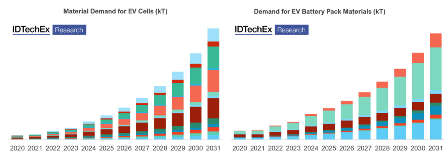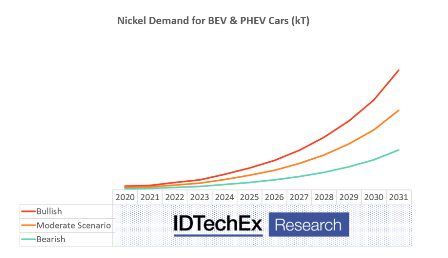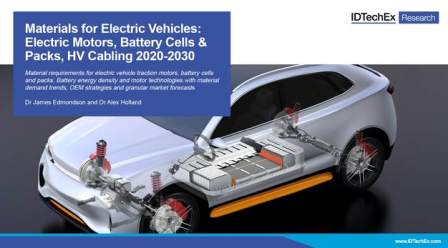Traction batteries are the key to electric vehicles (EVs). They present very different material requirements to the combustion engines they help replace.
Their meteoric rise will lead to much greater demand for several materials’ markets, which otherwise would see only modest growth. For example, while the combustion engine and transmission rely heavily on aluminum and steel alloys, Li-ion batteries also require a great deal of nickel, cobalt, aluminum, lithium, copper, insulation, thermal interface materials, and much more at the cell- and pack-level.
IDTechEx Research company has released a new spreadsheet-based tool that lists projections for several material intensities at a cell-and-pack level for the battery-electric vehicle (BEV) and plug-in hybrid vehicle (PHEV) batteries in the car market. It also provides a forecast for the multi-metal and other materials demand in tonnes from 2018-2031.

In addition to these forecasts, this tool allows you to use your own forecasts for BEV and PHEV unit sales and battery capacities to see how these variables impact demand over the next 10 years. A scenarios tool is also included, which allows for several sales forecasts to be compared simultaneously for individual materials.
Material intensities throughout the tool are determined, using extensive IDTechEx research which includes primary interviews with relevant players in the industry as well as an analysis conducted by collating secondary sources. A comprehensive model database of over 240 BEV and PHEV models sold between 2015-2020 is used to determine trends such as battery capacity, cell and pack energy density, thermal management strategy, cell geometry market shares, and cell chemistry market share.
Several components are considered in this tool. For the battery cells, the materials used in cathodes, anodes, electrolytes, separators, binders, and casings are forecast. For the battery pack, materials required for interconnects, enclosures, thermal management, thermal interface materials, inter-cell pads, and insulation and fire-retardant materials are forecast.

The materials that are covered and forecast in this tool are aluminum (cell- and pack- level), carbon black, cell casings, carbon fiber reinforced polymer, cobalt, copper (cell- and pack-level), fire-retardants, glass fiber reinforced polymer, graphite (anodes), inter-cell materials (encapsulants, cushioning, module housings, etc.), iron, lithium, manganese, nickel, polyvinylidene difluoride binder, silicon anodes, steel, thermal management, and thermal interface materials.
For more information around their projections, the technologies, trends, market analysis, and forecasting please see the report: “Materials for Electric Vehicle Battery Cells and Packs 2021-2031”.
©Copyright MOTORING WORLD INTERNATIONAL.
All rights reserved. Materials, photographs, illustrations and other digital content on this website, may not be reproduced, published, broadcast, rewritten or redistributed in whole or in part without prior written permission from Motoring World International
Contact: [email protected]




